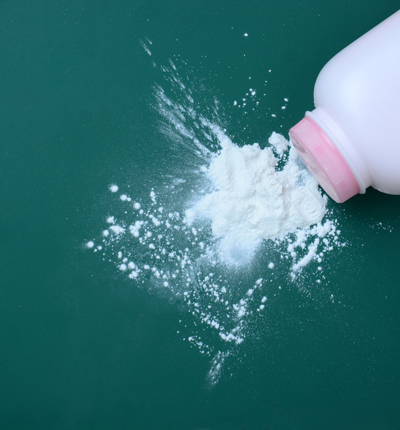
Talcum powder: a hidden source of asbestos exposure
Asbestos lawyer Catriona Ratcliffe discusses a recent US case against Johnson & Johnson concerning asbestos contaminated talcum powder.
Posted on 20 April 2018
One of the first questions a client is asked when they seek legal advice following diagnosis with an asbestos related disease is whether they know how they were exposed to asbestos. The symptoms of these diseases can take 30 or 40 years to develop so for many clients this can be a difficult question to answer.
Where there is a history of employment in heavy industrial jobs, such as factory work and shipbuilding, where the use of asbestos was commonplace, the client’s occupational asbestos exposure is a fairly obvious source of their injury.
In more recent years, with the decrease in industrialisation in Britain and the introduction of health and safety regulations, clients with asbestos related illnesses arising from occupational exposure are more likely to have been exposed to lower levels of asbestos, perhaps though a job that lasted for only a few days or even hours, where asbestos was used occasionally, or its presence in the workplace was not even immediately apparent. While less obvious, with some investigation, lawyers specialising in asbestos disease claims can still identify potential sources of exposure and bring successful claims.
Where no occupational exposure to the client or their family members can be established, the source of the injury may be much harder to determine leaving clients with no case to pursue and no prospect of receiving compensation. In these sorts of cases, a lawyer’s knowledge of other potential environmental sources of exposure can prove invaluable.
A recent decision in the US serves as a useful reminder of one such source: talcum powder.
Used for over a century for its ability to both absorb moisture and provide lubrication in cosmetic and industrial applications, talcum powder has been facing a reputational crisis of late thanks to its reported links to cancer.
Recent media attention has focussed on concerns that talcum powder is a possible cause of ovarian cancer, concerns that are, as yet, unproven. However, what is known is that talcum powder contaminated with asbestos can cause mesothelioma, an asbestos related cancer of the lining of the lungs and abdomen.
On 5 April 2018 Johnson & Johnson, producer of perhaps the best known brand of talcum powder, Johnson’s Baby Powder, and their talc supplier, Imerys SA, lost at trial to a man suffering from mesothelioma who claimed his illness was caused by use of their product dating back to 1972.
Talc, like asbestos, is a naturally occurring mineral. They often form in the ground alongside one another and, as a result, when talc is mined it can become contaminated with asbestos.
Talc used in products available today, including talcum powder and cosmetics such as eye shadow, foundation and pressed powders, are reportedly asbestos free (a study in 2009/10 by the Food and Drug Administration in America, albeit of a small sample of products, found no asbestos contamination). The same cannot be said for products available as late as 1976 when a study found asbestos contamination in 10 of the 20 samples of commercially available talcum powder tested.
Johnson & Johnson deny any contamination of their talc products with asbestos. They plan to appeal the decision stating they are confident their product did not cause the claimant’s cancer.
Regardless of the eventual outcome in the case against Johnson & Johnson, historic use of talcum powder contaminated with asbestos is a proven source of asbestos exposure and a potential cause of mesothelioma from what may at first appear a seemingly innocuous product.
Update 15 December 2018
A special report by the news agency Reuters published on 14 December 2018 claims that documents revealed in ongoing litigation in the US show that from 1971 to the early 2000s, Johnson & Johnson raw talcum powder and finished powders sometimes tested positive for small amounts of asbestos and that the company failed to disclose it to regulators or the public. Johnson & Johnson deny the allegations.


